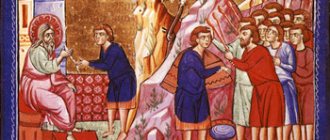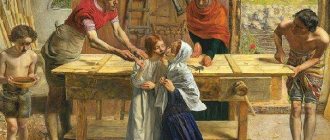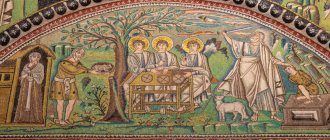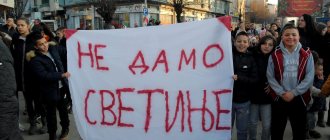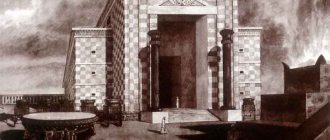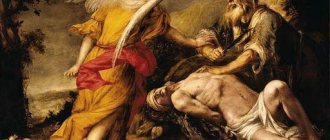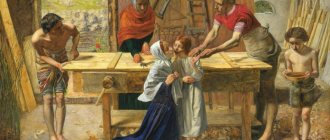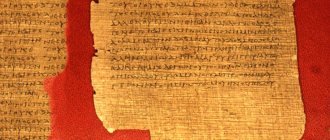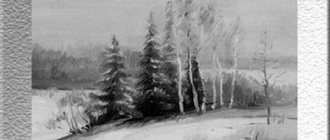“Salaphiel begot Zerubbabel...”
Estimated reading time: less than a minute.
At the very beginning of the Gospel of Matthew there are long and, for many of our contemporaries, incomprehensible, “boring” lists of the earthly ancestors of Jesus Christ. Moreover, for some reason some are described in detail, while others are only mentioned by name. The same list with minor differences is repeated in the Evangelist Luke... But can these lists of names of long-dead people be of interest to the modern reader of the Gospel? Does the genealogy of Christ have any significance today, and if so, what is it?
One day I had a chance to talk with a woman who decided to read the New Testament. Naturally, she opened it to the first page of the first book - the Gospel of Matthew. And she began to read: “The genealogy of Jesus Christ, the Son of David, the Son of Abraham. Abraham gave birth to Isaac; Isaac gave birth to Jacob; Jacob begat Judah and his brothers; Judah begot Perez and Zerah by Tamar...” Having delved into this list, she... closed the New Testament and did not want to open it anymore. True, she was first of all offended by the fact that, in her opinion, in this text, men gave birth to each other - a complete fairy tale, and also offensive to women, because in this genealogy, among male names, we encounter only four female ones. Of course, some ambiguity in the Synodal translation is also “to blame” - one could say more precisely: “Abraham became the father of Isaac.” But even with such clarification, the genealogy seems unnecessary, a boring list that you want to quickly scroll through in order to move on to more significant things. Moreover, this is a genealogy... of Joseph, who was not the father of Jesus Christ at all! Why is it needed at all then?
Earthly roots
We live in a completely different society from 1st century CE Palestine. e. But even to this day, and in large modern cities, you can find people for whom such lists are significant. I remember how I once picked up a Bashkir-Russian dictionary. As an appendix to it were given... lists of Bashkir clans and tribes, just like in the Old Testament! It turns out that for the creators of the dictionary - intellectuals with higher education living in Ufa, where all the clans and tribes have long been mixed, and on the streets they speak mainly Russian - it was extremely important to remember which of them belonged to which clan (this is determined by surname) and with which other clans his ancestors were closely related, and with which - distantly. What can we say about the North Caucasus! The first thing they learn about a fellow tribesman is what family he is, who his ancestors are, and this largely determines the further attitude towards him. And the Ingush have this custom: if a young guy who has gone somewhere to the city, far from his native land, has lost his way: he gets drunk, acts out, older men from his native village come to him, bring him home, take him to the graves of his ancestors and they make him swear that from now on he will behave differently. If you break such an oath, for your family you are as good as dead. Sometimes it is a pity that Russians no longer have such customs. Today, of course, in the Gospel we are interested primarily in the life, death and resurrection of Jesus Christ, His teaching, sermons and parables. But for a first-century Jew, the first question he would ask about Christ would be the question of His origin, His place in the social structure of society. That is why the Apostle Matthew, who wrote mainly for the Jews, begins with what is most essential for them - with genealogy. However, the Evangelist Luke also gives a list of the ancestors of Jesus Christ, but a little later, as an insert, at the end of the third chapter, which describes Jesus’ entry into public ministry. The family was led by the father, and Joseph, although he was not the biological father of Jesus, was His father according to the Law or, as we would say today, social, that is, he was perceived as a father by everyone around him. In general, biological paternity was not an unconditional criterion for belonging to a certain clan and family. In the Bible we read about the custom of levirate marriage: after the death of the older brother, the younger brother had to marry his widow, and the son born from this marriage was considered a descendant of the deceased, although everyone remembered who his biological father was. In the genealogy of Christ there is also such an example: from the levirate marriage of Boaz and Ruth - after the death of her first husband - Obed was born... But in the Old Testament it is said in detail about Boaz, but Ruth’s first husband is not known at all (we don’t even know exactly what his name was) name: Mahlon or Chileon), which is why Boaz is mentioned in the gospel genealogy. Perhaps the same levirate marriages explain the slight discrepancies between the two genealogies in Matthew and Luke: one mentions a biological father, the other a social one. However, there may be other explanations: the evangelists used different sources, and minor inaccuracies could creep into them. In any case, all the main points are completely the same. But women, generally speaking, were not required to be mentioned in the list of ancestors, so the appearance of female names in the genealogy (and there are only four of them in the list - Tamar, Rahab or Rahab, Ruth and Bathsheba) is not accidental. The author probably wanted to draw our attention to the biblical story associated with each of them. These women are written in detail in the Old Testament, and not at all because they were particularly pious. But a detailed discussion on this topic probably requires a separate article.
"...according to his kind"
The people of the ancient Near East generally loved lists. The most ancient Middle Eastern writing is Sumerian, and from the Sumerians it was mainly lists of literally everything in the world that came down to us: from an inventory of temple property to a list of professions or useful properties of this or that object, or simply “entities” (this is how the Sumerian word is translated to some approximation "meh") Each such list testifies to a person’s desire to streamline the world around him. We see the same thing in the Old Testament, where it is constantly emphasized that everything was done measuredly, in order, systematically. This also applies to the creation of the world, when the sun and moon were called upon to measure times and seasons, and each tree bore fruit not just any kind, but precisely “according to its kind.” All these clarifications are not interesting to us, but for the ancient Jew they were extremely important. To survive in the world, you need to structure it - distribute all phenomena into classes and treat each one, taking into account its generic properties. Those that do not fit into their class - for example, fish without fins and scales - are suspicious and should be avoided. This appears to be the basis for many of the dietary restrictions of the Old Testament, and many cases of ritual impurity are associated with the transition of a person from one class to another (for example, childbirth or death). This is how the chosen people, Israel, were created. He left Egypt not in a crowd, but as an organized army, in an orderly manner, in accordance with the clan structure of society. And on the promised land, people did not settle chaotically, in the spirit of the Wild West, but only on plots allocated to each tribe (that is, tribe), each clan within its tribe, each family within its clan. Of course, this also applied to worship: the Old Testament long, measuredly, and in detail lists all the subtleties of sacrifices, all the vessels and objects that were in the tabernacle, and then in the temple. Sometimes this detail even irritates the modern reader. So, in the book of Exodus, the Lord first explains to Moses in detail how to equip the tabernacle: make fifty copper hooks, and put the hooks in the loops, and connect the cover so that it makes one... and make a cover for the cover from red ram skins and another outer cover from skins blue (Exodus 26 :11-14). And then, instead of briefly reporting that everything was done exactly, the author lists each detail anew: ... and made fifty brass hooks to connect the covering ... and made for the tabernacle a covering of red rams' skins, and a covering on top of blue skins ( Exodus 36 :18-19). And such enumeration is even more important when we are talking about the chosen people standing before their God. So the priests cast lots to find out when to serve whom... And the first lot came out for Asaph, for Joseph; the second Gedaliah with his brothers and his sons; there were twelve of them; the third Zakkuru with his sons and his brothers; there are twelve of them; the fourth to Izri with his sons and his brothers; there are twelve of them; fifth Nephaniah... (1 Chronicles 25 :9-12) There are 24 shifts in total, and each is introduced with the same formula - no, to give a simple list of 24 names and a general characteristic for each of them! But, although the author did not then, as I do now, have a computer on which he could copy the same text ad infinitum, he carefully rewrote important words. Not a single priestly family should disappear; their list should not be reduced, turning living people into statistical units. This is how the lists of names sound during Orthodox services - tedious, unknown to us, but for someone dear and loved, not reducible to statistics. Perhaps it is no coincidence that in the concentration camps of the 20th century a person was deprived of his name before he was alive, and was made into a statistical unit in order to kill him? And then these lists will not seem so meaningless to us...
"...until the Reconciler comes"
Today we can hardly remember some of the names listed - for example, “Salafiel begat Zerubbabel.” But other names tell the reader a lot. In fact, here we have a brief glimpse of the entire history of salvation before Christ, the history of the chosen people. It is no coincidence that Matthew’s genealogy begins not with Adam or Noah (Luke would later trace the list of ancestors to them), but with Abraham, the first person whom the Lord chose to enter into a covenant with him, that is, an alliance. This union was renewed with his son Isaac and grandson Jacob—the Lord selected one in each generation to impart special blessings to. Starting with the sons of Jacob, selection gave way to multiplication: each of them was chosen, each of them was blessed by the father in his own way. And about one of his sons, Judah, he said mysterious words, which many interpreters attribute specifically to Christ, who came from the tribe of Judah: The scepter will not depart from Judah, nor the lawgiver from between his feet, until the Reconciler comes, and to Him the submission of the nations (Genesis 49 :10). This prophecy has always been understood by Jews as an indication that the Messiah will come from the tribe of Judah - and the Gospels confirm the fulfillment of the prophecy: in the list of Christ's ancestors, Judas is in its rightful place. Another very significant name is David. This is not just the second king of Israel and the founder of the dynasty, this is the man about whose descendant the Lord said: I will be his father, and he will be my son (2 Kings 7:14 ). In the immediate historical perspective, this was said about Solomon, who was to build the Temple of Jerusalem. But from ancient times, this prophecy was also understood as an indication of a distant descendant from the family of King David, who was destined to become the most authentic King of Israel, the Messiah, Christ, who would save his people and establish the Kingdom of God. That is why those who recognized Jesus as the Messiah called him “the son of David.” The prophecy that Christ would be a direct descendant of the psalmist king was always very important for the Jews, and therefore the Gospels specifically note that it was fulfilled. Even the numbers are not accidental: fourteen generations, as the evangelist notes, passed from Abraham to David, that is, from the first chosen one to the king chosen by God, and the same amount more until the Babylonian captivity. David's reign and captivity are like the zenith and nadir, the highest and lowest points of all Israeli history. Finally, fourteen more generations - until Christ himself. This number is not accidental; seven means a full term (the number of days in a week), and fourteen means double seven. It is no coincidence that the prophet Daniel, counting the date of the coming of the Messiah, counted in sevens... In a word, the history of the chosen people was fulfilled, the “fullness of times” had come - it was then that the Messiah should have been born. So the genealogies are given in the Gospel as evidence that, firstly, Christ was undoubtedly a historical figure, a real Man, and secondly, that all the prophecies about His origin were fulfilled literally. The evangelists seem to show in the few names of the Savior’s ancestors the story of suffering, restless humanity, which is still not alone. God does not leave him and directs him to a predetermined goal, to that great Meeting that we experience in the Gospel. That is why the Orthodox Church devotes the last two weeks of the Nativity Fast to the memory of the earthly ancestors of the Savior - not only the famous Abraham or David, but also everyone who lived, suffered, hoped and believed that all this was not in vain. And so it happened, because the story of Christ is their story too.
Illustrations by Natalia Kondratova
“Abraham begat Isaac, Isaac begat Jacob, Jacob begat Judah and his brothers...”
How the history of self-proclaimed Kosovo was created
News feed from 08/14/2020: “The law to protect the values of the struggle of the Kosovo Liberation Army (KLA) did not pass in the Kosovo parliament yesterday, since only 35 out of 68 deputies voted for it.
The values of the Kosovo Liberation Army, which this law must protect, are the armed struggle of the people of Kosovo under the leadership of the KLA for the liberation of Kosovo, the protection of war veterans and their movement, the protection of the flag and coat of arms of the KLA, the protection of monuments...” I think it’s time to remember how the UAC was created and what values made up the reinforcement of this structure, which they are now trying to concrete into a legend.
The Kosovo Liberation Army (the Serbs say OVK - Oslobodilachka Vojska Kosova, and the Albanians call it UCHK - Ushtria Çlirimtare e Kosovës or UÇK) also has its own pedigree.
Do you want to meet the “parents”?
…Welcome. We won’t go too deep into the years. We are interested in socialist Yugoslavia. The one who, barely born, inherited from monarchical Yugoslavia the infectious strain of Kosovo, which was treated with ointments of internationalism, and bitter potions of solidarity, and sweet dragees of equality, and divination about brotherhood, and shock therapy on the islands of Golo Otoka. But they only drove the disease deep. And it matured inside the body, and corroded it so much that it scattered the body into scraps, which still move, like a headless chicken, passing off its writhing as a full life.
So…
November 1944 - February 1945. The first mass clash between the JNA and the Albanian Bali Kombetar ("National Front"), which was formed, of course, in Drenica - the industry of Kosovo terrorism in recent decades.
About 15 thousand people under the leadership of Shaban Poluzhe, Adem Wotse and a handful of other leaders of various stripes. The Yugoslav People's Army sent as many as 4 brigades with a total of 40 thousand people against them. The rebellion was pacified, and the Albanians set out together to build socialism, although individual groups of “ballists” were followed through the mountains until the early 50s. They even made a film about it, it’s called “Captain Leshy.” And weapons were taken away from peaceful Albanian peasants until the 60s. This operation was led by the then chief of the UDB, Alexander Rankovich, aka Leka. It is his name – Leka Rankovic – that is still used to scare Albanian children.
Alexander Rankovich
In short, Leka took the weapon seriously. I selected and selected, but did not select.
Already in 1968, another attempt was made to shoot. But... there wasn’t enough gunpowder. And the Albanians understood the wisdom of young Ulyanov, and said: we will go a different way. And we went (in Lenin’s footsteps) straight to Switzerland. Create a base.
It was then that a group was created in Switzerland, which actively manifested itself during the 1974 demonstration: Jafer Satri and Kadri Osmanli comrades created GRK (Revolutionary Group of Kosovo), which even had its own newspaper - “Voice of Kosovo”.
In 1978, the revolutionaries were pinned down, and Jafer Satri and Kadri Osmanli began to build socialism, but forcibly - in the camps.
But a thing is strong when there is blood flowing underneath it, isn't it? In short, the “Decembrists” from the GRK woke up “Herzen” i.e. Kadri Zeku, who founded OMLK (Marxist-Leninist Organization of Kosovo) - well, I told you that we couldn’t do it here without Ilyich! - and began. And they published a newspaper - “Svoboda”.
However, there has never been a shortage of herzen and other cinders in Kosovo.
And there appeared:
1. Marxist-Leninist Party of Albanian Communists (PKLMS) led by Abdulah Prapašić (yes, another Leninist and Marxist! What?.. you can’t spoil the porridge with Lenins and there are never too many Lenins). By the way, at the same time, there was also a group on the territory of Macedonia called the Marxist-Leninist Group from Tetovo.
2. Red Popular Front of Ibrahim Kilmendi.
3. Revolutionary movement for the unification of Albanians (LRBS), the founder of which was Adem Demachi.
4. People's Liberation Movement of Kosovo and Albanian Territories in Yugoslavia (LKCKVSJ), led by Jusuf Grvala.
And about a dozen more groups and groups.
And they began to simply interfere with each other. Therefore, we gathered and signed a convention on the creation of LPRSK (National Movement for the Socialist Republic of Kosovo), divided the golden Arbatovsky, sorry, Kosovo section into several parts and put one leader in charge, who would “resolve” the situation if the convention was violated. At the same time, the commanders were quite autonomous in their actions (the structure operated successfully until 1999, and it was also adopted by international forces, which divided Kosovo into zones of influence with one centralized command from Pristina).
All these groups had their centers in Switzerland, and later in Germany, Austria, Holland and Sweden, which supplied them with money and weapons. Newspapers and proclamations were also published there. In short, Iskra is in action, and the Albanian Savva Morozovs began to donate a percentage of their profits to the revolution.
And in 1981, and then immediately in 1982, a serious attempt was made to squeeze the Serbian population out of Kosovo. The Serbs began to write petitions. In response, they received accusations of “nationalism and an attempt to destroy the stability of the SFRY.” This is what their authorities explained to them - with their fingers and police batons. From 1981 to 1991, 52 thousand Serbs left Kosovo.
Kosovar Albanian demonstration in Pristina in 1981
The tense eighties spawned two more bands:
- FNKC (People's Liberation Front of Kosovo) Bajram Bastri (died in 1984 during an action);
- PLK (Kosovo War Party) Recep Malyaj (also died “on duty” in ’84).
The situation in the region was brought under control. A curfew was introduced, and everyone again went to “strengthen brotherhood and forge unity” (or vice versa?). However, the Albanians did not suffer severe punishment: many leaders were allowed to go abroad, and some, such as Adem Demachi and Ibrahim Rugova, were warmed up and caressed by the authorities of the SFRY.
"Yeah!" - the guys said and created LPRK (National Movement for the Republic of Kosovo), which in 1985 was divided into two parts - the group of Recep Malyai and Saima Isufi and the group of Ibrahim Kilmendi (divided in Switzerland). And in June 1986, the GKK (Communist Group of Kosovo) was founded.
By the way, pay attention to the left-handed vocabulary in the titles. Honestly, interesting conclusions can be drawn...
Ibrahim Rugova in 1999 at NATO headquarters in Brussels
At the same time, the political star of Ibrahim Rugova (“President of the Republic of Kosovo” in 2002-2006) lit up. "He said 'Let's go!' and waved his hand." And the Albanians began their campaign in the battle for the Republic. A campaign that ended with manna from heaven: they wanted a republic within Yugoslavia, but they got... A STATE.
Thank you, sahib, thank you, white master...
But let's get back to our sheep, sorry, paramilitary groups.
GKK in 1991 was renamed ORS (Revolutionary Albanian Organization), and in 1992 became known as FRS (Revolutionary Party of Albanians).
In 1993, the Fatherland Calling Foundation was formed in Switzerland. The KLA was created with money from this fund, and held its first action in November 1994, although the official date of its establishment is considered to be November 1997, when the government of Kosovo, in the Swiss underground, announced a competition to hire Albanians for work - the state is mining.
Training took place in camps in Albania and Macedonia. However, learning the art of war was already easy: it was easy to shoot an arm in Bosnia and Croatia. In 1998, there were 1,884 attacks against citizens and police in Kosovo.
Let me remind you that there are 365 days in a year. How are you with math?
Now the UAC has been disbanded and renamed TDK.
But then Jacob gives birth to Job, and Job to Solomon. UCK gives birth to UCPMB, UCPMB -ANU, ANA, in turn, ROSU, ROSA gives birth to SB, and so on.
According to the United Nations Development Programme, there are from 330 to 460 thousand automatic weapons in Kosovo.
Illegal units.
The custom is like this... An ancient beautiful custom.
